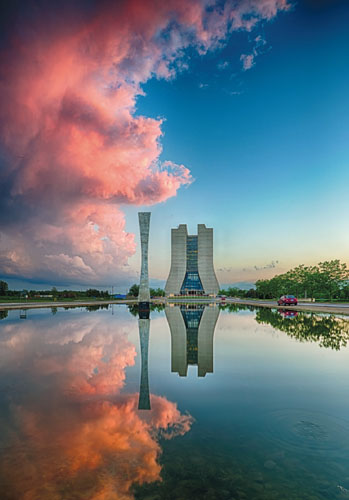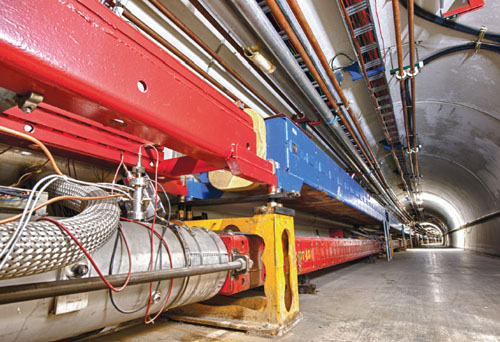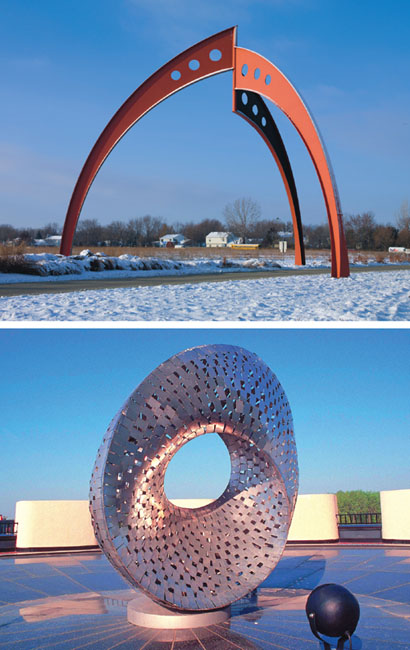Robert Wilson: Fermilab's Master Physicist, Sculptor, and Engineer
By Henry Petroski
The founder of one of the world’s leading particle colliders put his stamp on every aspect of the lab, from its aesthetics to its energy levels.
The founder of one of the world’s leading particle colliders put his stamp on every aspect of the lab, from its aesthetics to its energy levels.

DOI: 10.1511/2015.114.170
To discover and study some of the smallest particles in the universe, physicists need some of the largest machines in the world. These have gone by various names—accelerator, cyclotron, synchrotron, collider, not to mention atom smasher—and they are typically designed and developed by large teams of scientists and engineers. Presently, the largest machine in the world is the Large Hadron Collider built by the European Organization for Nuclear Research (CERN), whose 17-mile-long circular tunnel straddles the border between France and Switzerland. Since beginning full operation in 2009, the LHC has produced data said to confirm the existence of the long-sought-for elementary particle known as the Higgs boson.

Photograph courtesy of Fermilab.
Before the LHC came online, the largest particle accelerator was located about 40 miles due west of Chicago, just north of Aurora and Naperville, on a 6,800-acre irregular-polygon-shaped site of what had been sprawling Illinois farmland that spills over the line separating DuPage from Kane County. Founded in 1967 as the US National Accelerator Laboratory, in 1974 the site was renamed in honor of Enrico Fermi. Having a proper name affixed to its official designation allowed the Fermi National Accelerator Laboratory to be referred to simply as Fermilab. On a recent visit I was fortunate to have a host and guides who were steeped in its history and culture, about which I was happy to learn.
Fermilab is located on land that previously included the community of Weston, which was set amid typically Midwestern farmlands, farmhouses, fields, and barns that were home to numerous families and roaming livestock. In 1966, the Weston village board voted to let the Atomic Energy Commission acquire the village and the surrounding land to create a new national accelerator laboratory. Oversight of the design of the particle accelerator and the buildings and grounds that would form the site’s infrastructure fell to the laboratory’s founding director, Robert Rathbun Wilson, who has been described as a physicist’s physicist. He described himself as a physicist and a sculptor, and sometimes a cowboy.

AIP Emilio Segré Visual Archives
Robert Rathbun Wilson was born in 1914 in Frontier, Wyoming, in the southwestern part of the state. Its name fairly describes the nature of its surroundings; even today Frontier has a population numbering only about 100. Like many a boy growing up before the digital age, young Robert tinkered with physical hardware such as water pumps and vacuum tubes. But it was his education—both undergraduate and graduate—at the University of California at Berkeley that brought about his transformation to a physicist. As a graduate student he worked under Ernest O. Lawrence, director of Berkeley’s Radiation Laboratory, who became a Nobel Prize laureate for his invention of the cyclotron. During World War II Robert Wilson worked on the Manhattan Project. Afterward, he became director of the nuclear studies laboratory at Cornell University, a position he still held when he took a leave of absence to design and start up the new lab on the Illinois prairie. (In relating his role in the lab’s development, for simplicity I refer to it anachronistically as Fermilab.)
Wilson was often called a Renaissance man. In 1961, he attended Rome’s Academia Belle Arti and studied sculpture, which he pursued very seriously. His works were the subject of two shows in Cornell’s hometown of Ithaca, New York, and he was commissioned to create a piece of artwork for that city’s Festival Theater. It should have been no surprise that when Wilson became director of Fermilab, he saw large pieces of sculpture as an integral part of the laboratory’s landscape and culture.
Because the lab’s particle accelerator was built to serve as a national facility, locating it in a place more or less convenient to both East and West Coast centers of scientific research was a sensible compromise. The site also satisfied political considerations that the wealth of federal contracts should be geographically dispersed. Large atom-smashing machines need large parcels of real estate on which (and under which) to construct the machines along with their control rooms. Fermilab also required space on which to build structures for the administration, plus housing for the visiting graduate students, postdocs, and scientists who were expected to come from around the nation and around the world.
After residents of the village of Weston and surrounding farms were relocated, the new lab site was to be cleared of old buildings to make way for new. But Wilson, who seemed always aware of budget limitations, was too wise and frugal to tear down serviceable structures. Farmhouses were repurposed and, where necessary, relocated. Fermilab Village, located just inside the lab’s East Gate, is a concentration of modest preexisting buildings converted to dormitory and other uses. A warehouse in the Village became Wilson’s workshop for fabricating some of his sculptures that adorn the site. Today, village buildings are painted bright blues, reds, and oranges, emphasizing that they are not part of nature but rather are things added to it. Yet nature itself is treated with reverence within the lab’s confines, with stands of corn, fields of soybeans, restored prairie grass, ponds of swans, and a buffalo herd harkening back to what this land once was.
Shortly after I arrived at O’Hare Airport, a driver met me at baggage claim and took me to Fermilab, heading along the interstate highways and toll roads that snake through the western suburbs of Chicago. When we were within a few miles of our destination we left the highway and approached through Warrenville, along a narrow and unassuming residential street lined with trees, sidewalks, and modest houses that leads almost seamlessly from a Midwest small-town street to the lab’s site. After passing the Village, we drove for a while through what looked like unspoiled farm and prairie land. Wildlife was abundant on this late October day, especially migrating geese resting on the ground and flying in formation above it. But my thoughts soon changed to technology as I saw new and old industrial buildings of distinctive designs looming ahead. These were intermixed with classic Midwestern barns, which had been kept in place for storage.
Soon, as we came out of a gentle curve in the road, the centerpiece of the laboratory appeared: a tall, broad structure that towered over an otherwise crouching skyline. With the car winding around toward the High-Rise, as it was called during its design, I saw various aspects of the concrete-and-glass structure. First I saw it progressively from the side, as a not-uncommon, rectangular office block; then from a corner, as a transitional piece of architecture whose walls curve upward like those of a hydroelectric dam poised to convert stored energy into vast quantities of power; and from the front, straight on, as a channel of air confined behind glass, keeping apart a pair of massive, inward-leaning concrete buttresses. When I squinted I saw something resembling a space shuttle poised for liftoff, loaded with experiments that would add to our understanding of the universe—of outer and inner space. To Robert Wilson, who had so much to say about the architecture of this building and about the lab site generally, the vertically out-of-scale structure evoked the cathedral at Beauvais.
Wilson once tore up architectural plans that did not satisfy him and stomped on the scattered pieces.
Although architects were involved in its execution, the High-Rise—now commonly referred to as the Main Building, though formally named Robert Rathbun Wilson Hall—was effectively designed by Director Wilson. To emphasize that he had strong feelings about how the building should look, feel, and function, he reportedly once tore up architectural plans that did not satisfy him and stomped on the scattered pieces. Wilson wished to have as many lab staff as possible housed in the same building so they could interact easily. To establish how tall the building should be, he went up in a helicopter to determine the elevation necessary to take in the full expanse of the lab’s grounds. The answer proved to be more than 200 feet. And to keep costs down, Wilson specified that there should be no cladding on the exposed concrete structure, which was sculpted into irregularly inclined planes by the highly textured boards of random length and width that made up the formwork into which the concrete was placed. Rather than causing the building to look shoddy and unfinished, the effect is strikingly fresh looking, even after almost half a century.
The glass-walled ends of the tall atrium formed between the two halves of Wilson Hall—as well as the steel and glass roof—let in considerable natural light. The ends of the atrium are interrupted by crossovers that link the east and west sides and provide space for a coffee lounge, library, art gallery, and other communal and exhibition spaces. These cross floors were intended to be supported by post-tensioned concrete beams resting on bearing surfaces along which they could slip and slide to accommodate relative movement due to differing degrees of heating by the Sun and gusting of the wind on the two opposing halves of the structure. Unfortunately, appropriate joints were not installed properly during construction, and so after the completion of the building its occupants on occasion heard the steel strands inside the beams snap with a loud report when the movement could not be accommodated. The problem was eventually fixed by redoing the joints, at great expense.

Photograph courtesy of Fermilab.
Wilson’s intense engagement in the building of Fermilab reflected his belief that physicists “could design things that would be much prettier, sparser, and cheaper than what the professionals would design.” He also believed in taking risks to save money and make faster progress. When it came to the tunnel of the accelerator’s Main Ring, he decided that it would not rest on costly piles driven down to bedrock; rather, it would simply float on the stable soil of the Midwestern fields. His gamble paid off. At the same time, Wilson also insisted that the tunnel be large enough not only to accommodate the magnets and other necessary machinery, but also to leave space for possible (though not officially planned) upgrades.
As with the High-Rise, Wilson involved himself directly in the design of other laboratory buildings on the site. One of the many distinctive ones is the Meson Lab, which has supported a variety of experiments, including particle-scattering and quark-searching ones. To be flexible enough to replace and reconfigure equipment, the building’s long and wide interior space had to be built without columns and be able to accommodate an overhead crane. It was Wilson’s idea to use common steel culvert sections arranged in an arch-like pattern for the roof. This proved to be an architecturally striking solution, especially because the culvert half-sections were placed with their exposed interior up and their opposing sides painted blue and orange, theme colors that are repeated elsewhere on the site.
In front of Wilson Hall and aligned with its axis is a long reflecting pond, punctuated by a 32-foot-high exclamatory sculpture in the form of a “hyperbolic obelisk.” This work began with Wilson’s pencil sketches, which enabled the lab’s model shop to create a maquette out of Lucite. Fabrication of the full-scale metal sculpture required welding quarter-inch-thick stainless-steel plates together, but when Wilson learned that a professional welding job would cost $20,000 he vowed to do it himself. Because the laboratory welders were unionized, they threatened to walk out. To avoid that, Wilson joined the union and apprenticed himself to the master welder in the lab’s machine shop. Once qualified, he spent time on the sculpture before and after normal working hours, as well as during lunchtime and on weekends. Fabrication began in January 1978 and the finished piece was erected in early May of that year. When viewed from the proper angle and distance, the artwork appears to fill the gap between the two halves of the main building.
The hyperbolic obelisk is officially titled Acqua Alle Funi; the name translates from the Italian as “Water to the ropes,” which is how most lab staff refer to the sculpture. The allusion is to the ropes employed in the 16th-century relocation of the Vatican Obelisk to its now-familiar position in St. Peter’s Square. A competition had been won by the engineer Domenico Fontana, whose idea was to use large numbers of ropes leading from the obelisk to capstans, which many hundreds of men and horses were to turn in synchrony. When it was time to lift the obelisk onto its pedestal, the engineer demanded—under penalty of death—absolute silence from the crowd of onlookers so that the working crew could hear the leader’s commands. By noon of that day, the obelisk had been raised to about 45 degrees off the horizontal, but the ropes began to lengthen and slip on the capstans alarmingly. Suddenly, an old sailor in the crowd shouted, “acqua alle funi,” knowing that wetting the ropes would cause them to contract and so become functional again. The breach of orders for silence was excused because the outburst saved the day. By evoking this dramatic incident, Wilson’s prominently located sculpture conveys a message to lab workers that cooperation is essential and that sometimes it is beneficial to speak out of turn.
Wilson had the ground above the tunnels formed into a berm, to be a feature recognizable from airplanes.
The hyperbolic obelisk is but one of the Robert Wilson sculptures that grace the grounds of Fermilab. Behind the main building is Ramsey Auditorium, providing a curvilinear extension of the building’s tall and narrow atrium the way the choir in a Gothic cathedral is an extension of the nave. The wood used in the ceiling of the auditorium’s lobby and for handrails came from walnut trees that had been felled on the grounds by timber thieves but recovered and put aside for some future purpose, another manifestation of Wilson’s aversion to wasting money or materials and his desire to repurpose them to good ends with rich symbolic meaning. On the roof of the auditorium is a round pond, in the middle of which rests a stainless-steel sculpture in the form of a tubular Möbius strip.
A third Wilson sculpture plays a functional as well as an aesthetic role at Fermilab. Running along the northerly axis on which the building is oriented, a line of power poles supports the cables connecting the lab’s master substation to the more workaday transmission lines of the Commonwealth Edison Company just outside the northern boundary of the laboratory site. The Wilson-designed power poles consist of three steel tubes painted white: two long straight ones projecting upwards out of the ground at slightly divergent, off-vertical inclinations and one curved cross member joining the two near their tops and carrying the hardware from which hang the high-voltage cables. Each power tower is said by current lab associates to resemble a stylized Greek letter pi; whether or not that was Wilson’s intention I do not know.
These sculptures and other artistic features can easily be seen from an upper-floor lobby of Wilson Hall, as can the course of the linear and circular tunnels full of magnets, conduits, and tubes in which particle beams are accelerated and directed to their targets. When completed, the Main Ring was the highest-energy proton synchrotron in the world. Wilson had the ground above the tunnels formed into a berm, not only to provide shielding against radiation but also to be a feature recognizable from the viewing areas in the High-Rise and from airplanes, to remind people what this polygon of prairie is all about. But not everyone appreciated the lab’s value. When questioned during a congressional hearing about what the activity carried out at Fermilab was doing for the national defense, Wilson replied:
It only has to do with the respect with which we regard one another, the dignity of men, our love of culture…. It has to do with, are we good painters, good sculptors, great poets? I mean all the things that we really venerate and honor in our country and are patriotic about. It has nothing to do directly with defending our country except to help make it worth defending.
Although I had entered the lab site through the East Gate, I exited it late that afternoon through the main gate on the western side, which abuts the town of Batavia. Departing along Pine Street, my host and I passed through another of Wilson’s sculptures, a tripodal and grossly asymmetric-appearing arch-like one titled Broken Symmetry. It is constructed out of steel plate salvaged from the aircraft carrier USS Princeton and reformed into three large curved and punctured buttress-like components; those pieces lean against each other and are welded together some 50 feet above the road. The sculpture is famous for its seeming total lack of symmetry, emphasized by the opposite sides of the buttresses being painted blue and orange. The standard question to the uninitiated visitor seems to be: From what single viewpoint does the asymmetrical sculpture appear to be symmetric? This is not a difficult thing for an engineer brought up on orthographic projection to see. In fact, there are two views of the sculpture that reveal its symmetry: from directly above and from directly below the apex of the piece.

Photographs courtesy of Fermilab.
My host and I returned to the lab later that evening, to have cocktails at the Users’ Center, which also houses Chez Leon, the onsite restaurant with a fixed menu that gets rave reviews from the laboratory staff and visitors. Dinner lived up to expectations. Chez Leon is named for Leon Lederman, the physicist who became the second director of Fermilab, succeeding Wilson after he resigned in 1978 in protest of what he considered inadequate funding from Washington to increase the energy capacity of the accelerator. Lederman shared the 1988 Nobel Prize in Physics for the discovery of the muon neutrino—work conducted not at Fermilab, ironically, but at Brookhaven National Laboratory.
The original target energy for Fermilab’s main machine was 200 GeV (giga-electron-volts; or BeV for billion-electron-volts). But Wilson had grander goals in mind, which is why in the design of the tunnel of the Main Ring he had insisted that space be left for expansion. As director he deliberately chose Batavia as the laboratory’s official address because its post office—but not other neighboring ones—was able to assign Box 500 to the site. The number represented Wilson’s energy goal of 500 GeV for the accelerator even while it was still under construction. When he formally announced this new goal in 1971, he allowed that with modifications the machine might someday reach 1,000 GeV (or 1 TeV, for trillion-electron-volts). The machine that would achieve this was completed at Fermilab in 1983 and was named the Tevatron.
That level of energy was reached by using superconducting magnets, which not only doubled the collision energy but also reduced energy consumption because of the paucity of electrical resistance in the system. This was an especially persuasive argument in the midst of the energy crises of the 1970s. At the time, Fermilab had an annual power bill of approximately $10 million; saving half of that while increasing output was a no-brainer, at least to the physicists. The funding agencies in Washington were not so enthusiastic, however, and it was over this issue that Wilson tendered his resignation.
On my way back to O’Hare the next morning, the limo driver talked to me about Fermilab and how most people do not know about the important work going on there. He felt that the lab needed a marketing effort to inform the public how much ancillary good has come out of the place, such as the development of proton radiation therapy that is effective in shrinking cancerous tumors. He clearly admired the researchers and seemed to regret that he had not pursued the kind of education that their jobs require. Then he spoke warmly of his eight-year-old son, who had wanted to grow up to be a policeman until he read about drones on the Internet. The child had asked his father to buy him one, but the father said he would start his son out with a more affordable small remote-controlled helicopter. The son was clearly an outstanding candidate for one of Fermilab’s Saturday morning children’s programs held in the Lederman Science Center: another building designed by Wilson, this one echoing the low-profile prairie-style architecture of Frank Lloyd Wright.
Perhaps as a final statement of how important Fermilab had been to him, and as an assertion of how much influence he had over its philosophical and physical nature, Wilson arranged to be buried in the small Pioneer Cemetery that is located beside a back road on the site. His grave’s square-cornered headstone is appropriately different from the irregularly shaped, eroded ones marking the graves of prairie pioneers. The old headstones are propped up by piles of smaller stones, leaning under the influence of gravity like the sides of Wilson Hall. Wilson’s wife, Jane, is buried beside him on Fermilab land. Even in death he had his way with the site and the laboratory he so loved and formed.
I am grateful to Tom Carter, professor of physics at the College of DuPage for inviting me to speak in the Fermilab Arts & Lecture Series and for being a most gracious host. I am also grateful to Paul Czarapata, deputy head of the lab’s Accelerator Division, for an informative tour of Wilson Hall and the linear accelerator. And I owe thanks to Elvin Harms, who gave me a personalized tour of the advanced superconducting test accelerator facility.
©Henry Petroski
Click "American Scientist" to access home page
American Scientist Comments and Discussion
To discuss our articles or comment on them, please share them and tag American Scientist on social media platforms. Here are links to our profiles on Twitter, Facebook, and LinkedIn.
If we re-share your post, we will moderate comments/discussion following our comments policy.